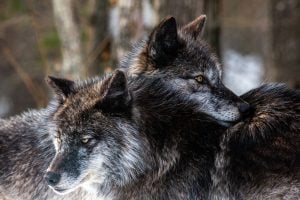
Science & Tech
20 Canadian innovations you should know about
Celebrating Canadian Innovation Week 2023 by spotlighting the people and organizations designing a better future
- 3327 words
- 14 minutes
This article is over 5 years old and may contain outdated information.
Science & Tech
There is only one total lunar eclipse to be seen in 2019, and it's set to colour the moon red tonight

Canadian stargazers only have one opportunity to glimpse a total lunar eclipse this year, but for those who can see it, it’s going to be spectacular — and it’s happening tonight.
It’s being called a ‘Super Blood Wolf Moon’ on social media, which, while it sounds exciting (and a bit scary), doesn’t differ drastically from a typical lunar eclipse. The term can be explained by a few factors: distance, appearance and timeliness.
At the time of the eclipse, the moon will be full and nearly at perigee, meaning closest to Earth in its elliptical orbit. In recent years, this phenomenon has come to be popularly known as a ‘super moon.’ Gazers can expect a fuller, brighter celestial body in the sky: on average, super moons appear 14 percent larger and 30 percent brighter than regular full moons.
‘Blood’ refers to the moon’s hue during a lunar eclipse. “Total lunar eclipses are quite rare celestial events, which occur when the moon passes into the Earth’s shadow,” explains Dr. Rachel Ward-Maxwell, an astrophysicist and researcher in astronomy and space sciences at the Ontario Science Centre. “Once it reaches totality, the moon will appear a reddish-brown colour, illuminated only by the sunlight refracted by the Earth’s atmosphere.”
Although, there is still a possibility that the eclipse sends the moon into darkness, with no red glow. “The brightness of the blood Moon depends on how much dust is in the Earth’s atmosphere, similarly to how the redness of the sky during a sunrise or sunset varies from day to day,” says Ward-Maxwell.
The final part of the name comes from the timing of the eclipse. In some folkloric traditions, the full moon in January is called the “Wolf Moon.”
For observers in the Eastern time zone, the show will commence with a partial eclipse at 10:33 p.m., while the total eclipse will hold the sky from 11:41 p.m. on January 20 to 12:43 a.m. on January 21. That means the eclipse will begin at 9:33 p.m. in the Central time zone, 8:33 p.m. in the Mountain time zone, 11:33 p.m. in the Atlantic time zone and so on. The ‘Super Blood Wolf Moon’ will be visible in total eclipse from coast-to-coast-to-coast for 62 minutes, weather permitting. Unlike a solar eclipse, you can safely view a lunar eclipse with the naked eye.
Scroll down to see photos of the eclipse captured by #ShareCanGeo users on Instagram.
Are you passionate about Canadian geography?
You can support Canadian Geographic in 3 ways:

Science & Tech
Celebrating Canadian Innovation Week 2023 by spotlighting the people and organizations designing a better future

Travel
The trail started with a vision to link Canada coast to coast to coast. Now fully connected, it’s charting an ambitious course for the future.

Wildlife
Canada jays thrive in the cold. The life’s work of one biologist gives us clues as to how they’ll fare in a hotter world.

Wildlife
Exploring our love-hate relationship with the wolf